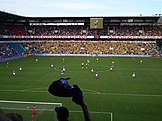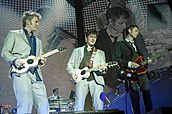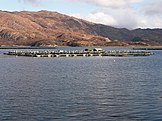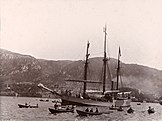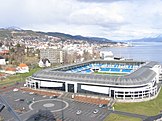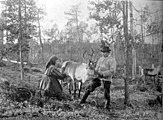Portal:Norway/Selected article
Instructions
- Add a new Selected article to the next available subpage. Use {{Selected article}}.
- Only articles that have been given a "B" class rating or higher should be added.
- Update parameter
|max=to new total for its {{Random portal component}} on the main page.
Selected articles list
Portal:Norway/Selected article/1
Chrome Division is a heavy metal band from Norway formed in 2004 by Shagrath, the lead vocalist of symphonic black metal band Dimmu Borgir, and Lex Icon, founder of The Kovenant. Although it was not intended as such, it is now considered a side project of Shagrath's, and the current lineup consists of him on rhythm guitar, along with Eddie Guz as the vocalist, Ricky Black on lead guitar, Björn Luna on bass guitar and Tony White on drums. The band plays in the style of bands such as Motörhead, and draws heavily upon imagery from the motorcycling subculture. To date, Chrome Division has released one album, Doomsday Rock 'N' Roll, but the band has signed a three-album deal with Nuclear Blast, and both Shagrath and Luna have promised that there are more to come. Chrome Division also released a music video for the song "Serial Killer" in an attempt to publicise the album, directed by noted Swedish director Patrick Ullaeus. (Full article...)Portal:Norway/Selected article/2
The naval Battle of Svolder (Svold, Swold) was fought in September 999 or 1000 somewhere in the western Baltic between King Olaf Tryggvason of Norway and an alliance of his enemies. The backdrop of the battle is the unification of Norway into a single state, long-standing Danish efforts to gain control of the country, and the spread of Christianity in Scandinavia. King Olaf was sailing home after an expedition to Wendland (Pomerania), when he was ambushed by an alliance of Svein Forkbeard, King of Denmark, Olaf Eiríksson, King of Sweden, and Eirik Hákonarson, Jarl of Lade. Olaf had only 11 warships in the battle against a fleet of at least 70. His ships were cleared one by one, last of all the Long Serpent, which Jarl Eirik captured as Olaf threw himself into the sea. After the battle, Norway was ruled by the Jarls of Lade as a fief of Denmark and Sweden. The most detailed sources on the battle, the kings' sagas, were written approximately two centuries after it took place. Historically unreliable, they offer an extended literary account describing the battle and the events leading up to it in vivid detail. The sagas ascribe the causes of the battle to Olaf Tryggvason's ill-fated marriage proposal to Sigrid the Haughty and his problematic marriage to Thyri, sister of Svein Forkbeard. As the battle starts Olaf is shown dismissing the Danish and Swedish fleets with ethnic insults and bravado while admitting that Eirik Hákonarson and his men are dangerous because "they are Norwegians like us". The best known episode in the battle is the breaking of Einarr Þambarskelfir's bow, which heralds Olaf's defeat. In later centuries, the saga descriptions of the battle, especially that in Snorri Sturluson's Heimskringla, have inspired a number of ballads and other works of literature. (Full article...)Portal:Norway/Selected article/3
The Norwegian Jarmann M1884 was among the first bolt action repeating rifles to be adopted in the Western world. Its adoption, and subsequent modifications, turned the Norwegian Army from a fighting force armed with single-shot black powder weapons into a force armed with modern repeating weapons firing smokeless ammunition. Several thousand were manufactured to equip both Norwegian and Swedish forces in the 1880s. The design is unique, and was the brainchild of Norwegian engineer Jacob Smith Jarmann. After the design had been phased out of the Norwegian Army, a number of the weapons were rebuilt as harpoon guns. (Full article...)Portal:Norway/Selected article/4
Röyksopp (Norwegian: [ˈrœ̂ʏksɔp]) is a Norwegian electronic music duo from Tromsø, formed in 1998. Since their inception, the band's line-up has included Svein Berge and Torbjørn Brundtland. Berge and Brundtland were introduced to each other through a mutual friend in Tromsø, Norway. They both enjoyed the same films, music and both shared an interest in electronics. The two experimented with various forms of electronic music, and bought a drum machine together during the Tromsø techno scene before going their separate ways. Several years later, the two met up again and formed Röyksopp during the Bergen Wave. After experimenting with different genres of electronic music, the band solidified their place in the electronica scene with their 2001 debut album, Melody A.M., released on the Wall of Sound record label. Röyksopp has consistently experimented with various genres pertaining to electronica. Stylistically, the band makes use of various genres, including ambient, house music, synthpop and African-American sounds. The band is also known for its elaborate concert performances, which often feature eccentric outfits. Since their 1998 debut, the duo has gained critical acclaim and popular success around the world. To date, Röyksopp has been nominated for one Grammy Award, won seven Spellemannprisen awards, performed worldwide tours, and produced albums which have topped the charts in several countries, including four consecutive number-one albums in their native Norway. (Full article...)Portal:Norway/Selected article/5
Oslo Airport, Fornebu (IATA:Portal:Norway/Selected article/6
The Krag-Petersson rifle was the first repeating rifle adopted by the armed forces of Norway, and one of the first repeating arms used anywhere in the world. Developed by Ole Herman Johannes Krag, the action of the Krag-Petersson was uniquely actuated by the oversized hammer. Another distinguishing feature was that the cartridge rising from the magazine was not seated automatically, but had to be pushed into the breech of the rifle. Testing by the Norwegian military revealed that the Krag-Petersson was a robust, accurate and quick firing weapon, and the Royal Norwegian Navy adopted the rifle in 1876. The rifle was also extensively tested by other nations, but not adopted. After being phased out around 1900, the remaining rifles were sold off to civilians, and often extensively rebuilt. Today it is so difficult to find one in original condition that the Krag-Petersson has been described as "the rifle everybody has heard about, but hardly anybody has ever seen". It was the first rifle designed by Ole H. J. Krag to be adopted by an armed force. (Full article...)Portal:Norway/Selected article/7
Operation Clambake, also referred to by its Web address, Xenu.net, is a website launched in 1996 that publishes mostly critical information about the Church of Scientology. It is owned and maintained by Andreas Heldal-Lund, who has stated that he supports the rights of all people to practice Scientology or any religion, though Operation Clambake has also referred to Scientology as: "a vicious and dangerous cult that masquerades as a religion." The site includes articles, exposés, and primary source documents. The site has been ranked as high as the third spot in Google searches for the term "Scientology". After the site hosted Scientology documents pertaining to Xenu and OT III, the Church of Scientology attempted to get this material removed through use of the Digital Millennium Copyright Act (DMCA). After receiving a DMCA takedown notice, Google removed many Xenu.net pages from its indexes. This inspired Google to contribute to the Chilling Effects archive, informing others about material missing from Google indexes due to DMCA takedown notices and other legal threats. (Full article...)Portal:Norway/Selected article/8
Ullevaal Stadion is an all-seater football stadium located in Oslo, Norway. It is the home ground of Vålerenga IF and the Norway national football team, and the site of the Norwegian Cup Final. From its opening in 1926 to 2009 it was the home ground of FK Lyn. With a capacity of 25,572, it is the largest football stadium in Norway. The national stadium is fully owned by the Football Association of Norway (NFF). The stadium opened on 26 September 1926 as the home ground for Lyn and several other local teams. The first international match was played in 1927, and NFF started gradually purchasing part of the stadium company. The peak attendance dates from 1935, when 35,495 people saw Norway play Sweden. Since 1948, Ullevaal has hosted the finals of the Norwegian Football Cup, and in 1967 the Japp Stand was completed. A new renovation started with the completion of the single-tier West Stand in 1985, and continued with the two-tier North and East Stands in 1990 and the South Stand in 1998. Ullevaal hosted the finals of the UEFA Women's Euro in 1987 and 1997. In conjunction with the stadium is the head office of many sports federations, a bandy field, and commercial property including a conference center, hotel and shopping mall. The stadium is located adjacent to Ullevål Stadion Station of the Oslo Metro and the Ring 3 motorway. Plans call to replace the West Stand to increase capacity to 30,000 and perhaps add a retractable roof and artificial turf. (Full article...)Portal:Norway/Selected article/9
The 2010 Nobel Peace Prize was awarded to imprisoned Chinese human rights activist Liu Xiaobo "for his long and non-violent struggle for fundamental human rights in China". The laureate, once an eminent scholar, was reportedly little-known inside the People's Republic of China (PRC) at the time of the award due to official censorship; he is a veteran of the Tiananmen Square protests of 1989, and a co-author of the Charter 08 manifesto for which he was sentenced to 11 years in prison on 25 December 2009. Liu, who was backed by Václav Havel and Desmond Tutu, received the award among a record field of more than 200 nominees. The decision, while widely praised by foreign intellectuals and politicians, was attacked by the Chinese government and the state media. A number of countries, including Saudi Arabia and Russia, also denounced the award and what they regarded as interference in China's domestic affairs. Following the announcement, official censorship was applied within China—on the Internet, television, and in print media. The government strongly denounced the award, and summoned the Norwegian ambassador in Beijing to make a formal protest. The Chinese authorities arrested citizens who attempted to celebrate. Liu's wife was put under house-arrest before the decision of the Nobel Committee was announced. (Full article...)Portal:Norway/Selected article/10
"Take On Me" is a song by the Norwegian synthpop band A-ha. Written by the band members, the song was produced by Alan Tarney for the group's first studio album Hunting High and Low, released in 1985. The song combines synthpop with a varied instrumentation that includes acoustic guitars, keyboards, and drums. The original "Take on Me" was recorded in 1984, and took three releases to chart in the United Kingdom, reaching number two on the UK Singles Chart in November 1985. In the United States, the song reached the top position of the Billboard Hot 100 in October 1985, due in no small part to the wide exposure of its memorable and cutting-edge music video on MTV, directed by Steve Barron. The video features the band in a pencil-sketch animation method called rotoscoping, combined with live action. The video won six awards, and was nominated for two others at the 1986 MTV Video Music Awards. (Full article...)Portal:Norway/Selected article/11 Situated in Møre og Romsdal county, Norway, Atlanterhavsveien (lit. The Atlantic Road) is the part of National Road No. 64 (RV 64) that connects the island of Averøy to Vevang, Eide, on the mainland; by extension, the road connects the cities of Kristiansund and Molde. Construction work on the road started on August 1, 1983, with the opening taking place on July 7, 1989. During this period there were no less than 12 hurricanes in the area. The 8.3 km (5 mile) long road is built on several small islands and skerries, and is spanned by eight bridges and several landfills. This road has an open sea view which is not so common for roads along the Norwegian coast, since there are archipelagos that obscures this view. Here the distance between the islands is so small that a road could be built across the archipelago. In addition there are fjords and mountains inside the road. (Full article...)
Portal:Norway/Selected article/12
The first expedition to reach the geographic South Pole was led by the Norwegian explorer Roald Amundsen. His party arrived at the pole on 14 December 1911, five weeks ahead of a British team led by Robert Falcon Scott. Amundsen and his companions returned safely to their base, and later learned that Scott and his four companions had died on their return journey. Amundsen's initial plans had been to explore the Arctic, but he decided to go south on hearing that both Frederick Cook and Robert E. Peary were claiming to have reached the North Pole. However, he kept this revised objective secret until after his departure. The expedition arrived in Antarctica in January 1911 and after months of preparation the five-man polar party set out in October 1911. The route from their base at the Bay of Whales took them across the Great Ice Barrier and up the Axel Heiberg Glacier. The party's mastery of the use of skis and their expertise with sledge dogs ensured rapid and relatively trouble-free travel. Although the expedition's success was widely applauded, the story of Scott's heroic failure and tragic death overshadowed its achievements. For his decision to keep his true plans secret until the last moment, Amundsen was criticised for what some considered deception on his part. (Full article...)Portal:Norway/Selected article/13
Marine Harvest ASA, Pan Fish prior to February 6, 2007, is a Norwegian seafood company with operations in a number of countries around the world. The company's primary interest is the production, processing and sale of farmed salmon, the operations of which are focused on Norway, Scotland, Canada, the Faroe Islands, Ireland and Chile. The group has a share of between 25 and 30% of the global salmon and trout market, making it the world's largest company in the sector. Marine Harvest also owns a 'value added processing' unit, which prepares and distributes a range of seafood products, and a number of smaller divisions. The company assumed its current form as a result of massive expansion in 2006, when Pan Fish ASA conducted an effective three-way merger with Marine Harvest N.V. and Fjord Seafood. The group is headquartered in Oslo and is listed on the Oslo Stock Exchange where it is a constituent of the benchmark OBX Index. (Full article...)Portal:Norway/Selected article/14
In the "Black Friday" air attack of World War II a force of Allied Bristol Beaufighter aircraft suffered heavy casualties during an unsuccessful attack on German destroyer Z33 and her escorting vessels on 9 February 1945. The German ships were sheltering in a strong defensive position in Førde Fjord, Norway, forcing the Allied aircraft to attack through heavy anti-aircraft fire. The Beaufighters and their escort of North American P-51 Mustang fighters were also surprised by twelve German Focke-Wulf Fw 190 fighters. In the resulting attack the Allies damaged at least two of the German ships for the loss of seven Beaufighters shot down by flak guns. Another two Beaufighters and one Mustang were destroyed by the Fw 190s. Either four or five German fighters were shot down by the Allied aircraft, including one flown by an ace. Due to the losses suffered in this raid the Allied anti-shipping force adopted new tactics which placed a lower priority on attacking warships. (Full article...)Portal:Norway/Selected article/15
Nansen's Fram expedition was an 1893–1896 attempt by the Norwegian explorer Fridtjof Nansen to reach the geographical North Pole by harnessing the natural east–west current of the Arctic Ocean. In the face of much discouragement from other polar explorers Nansen took his ship Fram to the New Siberian Islands in the eastern Arctic Ocean, froze her into the pack ice, and waited for the drift to carry her towards the pole. Impatient with the slow speed and erratic character of the drift, after 18 months Nansen and a chosen companion, Hjalmar Johansen, left the ship with a team of dogs and sledges and made for the pole. They did not reach it, but they achieved a record Farthest North latitude before a long retreat to Franz Josef Land. Meanwhile Fram continued to drift westward, finally emerging in the North Atlantic Ocean. The ship was rarely threatened during her long imprisonment, and emerged unscathed after three years. The scientific observations carried out during this period contributed significantly to the new discipline of oceanography, which subsequently became the main focus of Nansen's scientific work. Fram's drift and Nansen's sledge journey proved conclusively that there were no significant land masses between the Eurasian continents and the North Pole, and confirmed the general character of the north polar region as a deep, ice-covered sea. (Full article...)Portal:Norway/Selected article/16
Opera is a web browser and internet suite developed by the Opera Software company. Opera handles common Internet-related tasks such as displaying web sites, sending and receiving e-mail messages, managing contacts, IRC online chatting, downloading files via BitTorrent, and reading web feeds. Opera is offered free of charge for personal computers and mobile phones, but for other devices it must be paid for. Features of Opera include tabbed browsing, page zooming, mouse gestures, and an integrated download manager. Its security features include built-in phishing and malware protection, strong encryption when browsing secure web sites, and the ability to easily delete private data such as cookies and browsing history by simply clicking a button. Opera runs on a variety of personal computer operating systems, including Microsoft Windows, Mac OS X, Linux, FreeBSD, and Solaris. Though evaluations of Opera have been largely positive, Opera has captured only a fraction of the worldwide personal computer browser market. Opera has a stronger market share on mobile devices such as mobile phones, smartphones, and personal digital assistants. Editions of Opera are available for devices using the Symbian and Windows Mobile operating systems, as well as Java ME-enabled devices. Approximately 40 million mobile phones have shipped with Opera pre-installed. (Full article...)Portal:Norway/Selected article/17
Air Norway AS is a virtual, regional airline with its head office in the town of Brekstad, the administrative centre of the municipality of Ørland, in Sør-Trøndelag county, Norway. It operates seven round trips a week from its hub at Ørland Airport to Oslo Airport, Gardermoen, and a single, weekly round trip from Oslo to Aalborg Airport, Denmark, using a wet leased Fairchild Metro aircraft from North Flying. The airline was established in 2003. Following the bankruptcy of Coast Air in January 2008, the airline stepped in and was serving Fagernes Airport, Leirin with two daily flights to Oslo, and one daily flight to Trondheim, but these were terminated in 2009. (Full article...)Portal:Norway/Selected article/18
The Kalmar Union (Danish, Norwegian and Swedish: Kalmarunionen) is a historiographical term meaning a series of personal unions (1397–1524) that united the three kingdoms of Denmark, Norway (with Iceland, Greenland, Faroe Islands, Shetland and Orkney) and Sweden (including some of Finland) under a single monarch, though intermittently. The countries had not technically given up their sovereignty, nor their independence, but in practical terms, they were only autonomous, the common monarch holding the sovereignty and, particularly, leading foreign policy; diverging interests (especially the Swedish nobility's dissatisfaction over the dominant role played by Denmark and Holstein) gave rise to a conflict that would hamper the union in several intervals from the 1430s until the union's breakup in 1523 when Gustav Vasa became king of Sweden. The union was never formally dissolved - some argue that its conception actually was never ratified either. Norway and her overseas dependencies, however, continued to remain a part of the realm of Denmark-Norway under the Oldenburg dynasty for several centuries after the dissolution. (Full article...)Portal:Norway/Selected article/19
Aker Stadion, formerly known as Molde Stadion, is a football stadium located at Reknes in Molde, Norway, and is the home of Norwegian Premier League club Molde. The stadium has a capacity of 11,800 spectators. The building was designed by architect Kjell Kosberg. It cost 212 million kr, most of which was paid for by club-owner Kjell Inge Røkke—after whom the ground has been nicknamed "Røkkeløkka". The main construction work took place 1997, and the stadium was inaugurated on 18 April 1998 in a league game against Lillestrøm, replacing Molde idrettspark as Molde's home ground. The stadium was nominated for the FIABCI Prix D' Excellence and awarded the City Prize in 1999. The record attendance of 13,308 was set in a league match against Rosenborg in 1998. The same year, the arena hosted its only international match, where Norway beat Saudi Arabia 6–0. The following year, when Molde reached the UEFA Champions League, the stadium was converted to an all-seater, reducing its capacity. Since May 2006, the stadium name has been sponsored by Røkke's company Aker. (Full article...)Portal:Norway/Selected article/20
Kvens (kveeni in Kven language / Finnish; kvener in Norwegian, and láddelažžat in Northern Sami) are a Norwegian ethnic minority descended from Finnish peasants and fishermen who emigrated from the northern parts of Finland and Sweden to Northern Norway in the 18th and 19th centuries. In 1996 the Kvens were granted minority status in Norway, and in 2005 the Kven language was recognized as a minority language in Norway. The term Kven has been continuously in use in Norway, from the Middle Ages up to the present age, to describe descendants of Finnish speaking people who immigrated to Northern Norway from the 16th century up to World War II. The origin of the term Kven is disputed as is the fate of the medieval Kvens. There is little evidence that modern Kvens are direct descendants of Kvenland mentioned in a few ancient Norwegian and Icelandic sources. Due to the discrimination and suppression by the Norwegian authorities the term Kven became derogatory in the late 19th century. Therefore, many Kvens, preferred to be called 'suomalaiset' (finns). But with the revitalization of the Kven culture in the 1970s Kvens themselves started using the term. However, even in the 1990s there was a debate whether the Norwegian terms 'finne', 'finsk', or 'finskætted' (respectively a Finnish person, Finnish, and of Finnish origin) should be used instead. However, today the term Kven is accepted and used for example in the name of the Kven organization in Norway (Norske Kveners Forbund). (Full article...)Portal:Norway/Selected article/21
Flytoget AS (branded in English as the Airport Express Train) is a high-speed airport rail link connecting Oslo Airport, Gardermoen to Oslo, Norway, in 19 minutes.The sixteen BM71 trains run on the Gardermobanen high-speed railway line, normally every ten minutes, with every other service continuing westwards to Asker. These serve eight stops, with plans to extend to Drammen in 2009. Flytoget transported 5.4 million passengers in 2007, a 34% market share of airport ground transport. The service is the only high-speed rail service in operation in Norway. The company was founded in 1992 and operations started in 1998; during construction the tunnel Romeriksporten had a leak, draining two lakes and delaying the opening the tunnel one year. Flytoget is owned by the Norwegian Ministry of Trade and Industry. (Full article...)Portal:Norway/Selected article/22
The Oslo Metro is the rapid transit system of Oslo, Norway, operated by Oslo T-banedrift on contract from the transit authority Ruter. The network consists of six lines that all run through the city center, with a total length of 84.2 kilometres (52.3 mi). It has a daily ridership of 200,000 with 105 stations of which 16 are underground or indoors. In addition to serving all 15 boroughs of Oslo, two lines run to Bærum. The first rapid transit line was the Holmenkoll Line, opened in 1898, with the branch Røa Line opening in 1912. It became the first Nordic underground railway in 1928 when the underground line to Nationaltheatret was opened. The Sognsvann Line opened in 1934 and the Kolsås Line in 1942. The opening of the upgraded T-bane system on the east side of town occurred in 1966, after the conversion of the 1957 Østensjø Line, followed by the new Lambertseter Line, the Grorud Line and the Furuset Line; in 1993 trains ran under the city between the two networks in the Common Tunnel, followed by the 2006 opening of the Ring Line. Between 2006 and 2010 the system is replacing the older T1000 stock with MX3000 stock. (Full article...)Portal:Norway/Selected article/23
The Bergen Line (Norwegian: Bergensbanen), also called the Bergen Railway, is a 371 kilometres (231 mi) standard gauge railway line between Bergen and Hønefoss, Norway. The name is often applied for the entire route from Bergen via Drammen to Oslo, where the passenger trains go, a distance of 496 kilometres (308 mi). It is the highest mainline railway line in Northern Europe, crossing the Hardangervidda plateau at 1,237 metres (4,058 ft) above sea level. The railway opened from Bergen to Voss in 1883 as the narrow gauge Voss Line. In 1909 the route was continued over the mountain to Oslo and the whole route converted to standard gauge, and the Voss Line became part of the Bergen Line. The line is single track, and was electrified in 1954–64. The Bergen Line is owned and maintained by the Norwegian National Rail Administration (Jernbaneverket), and served with passenger trains by Norges Statsbaner (NSB) and freight trains by CargoNet. The Flåm Line remains as the only branch line, after the closure of the Hardanger Line. The western section from Bergen to Voss is also served by the Bergen Commuter Rail, and was shortened following the 1966 opening of the Ulriken Tunnel. (Full article...)Portal:Norway/Selected article/24
The Gardermoen Line (Norwegian: Gardermobanen) is a high-speed railway line between Oslo and Eidsvoll, Norway, running past Lillestrøm and Oslo Airport, Gardermoen. The line is 64 kilometres (40 mi) long and replaced the older Hoved Line as the main line north-east of Oslo. The geriatric Hoved Line now handles commuter and freight traffic, while the Gardermoen Line handles high-speed passenger trains and freight trains laden with jet fuel for the airport. Both lines are owned by the Norwegian National Rail Administration. The line was opened in 1998, at the same time as the airport that gave the line its name. It is used by the Airport Express Train as well as express trains by Norges Statsbaner. It is the only high-speed railway in the kingdom, with a maximum permitted speed of 210 km/h (130 mph). Most of the line between Oslo and Lillestrøm is through the 14,580-metre (47,830 ft) long Romeriksporten tunnel—the longest railway tunnel in Norway. The decision to build the line was made in 1992; construction started two years later. The line was subjected to severe criticism during construction when the Romerike Tunnel sprung severe leaks due to hurried construction. As a result, the tunnel was opened a year after the rest of the line. (Full article...)Portal:Norway/Selected article/25
The Rjukan Line (Norwegian: Rjukanbanen), at first called the Vestfjorddal Line, was a 16-kilometre (10 mi) Norwegian railway line running through Vestfjorddalen between Mæl and Rjukan in Telemark. The railway's main purpose was to transport chemicals from Norsk Hydro's plant at Rjukan to the port at Skien, in addition to passenger transport. At Mæl the wagons were shipped 30 kilometres (19 mi) on the Tinnsjø railway ferry to Tinnoset where they connected to the Tinnos Line. The Rjukan Line and the ferries were operated by Norsk Transport, a subsidiary of Norsk Hydro. Construction of the line started in 1907, and it opened two years later. It became the second Norwegian railway to be electrified in 1911. It experienced heavy growth, and had fifteen electric locomotives in use. During World War II it was the scene of the Norwegian heavy water sabotage. After the 1960s production declined, and the railway was closed in 1991. It was kept as a heritage railway. (Full article...)Additions
- Feel free to add Featured or Good quality Norway articles to the above list.








